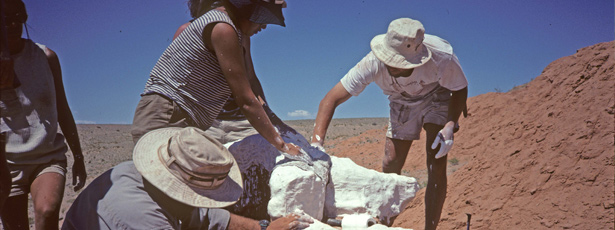Safety in the Field
Field activities can generally be broken into two categories, prospecting and excavation. Both tasks can be considered high risk.
Prospecting
Prospecting for fossils typically involves strenuous hiking for many miles over difficult terrain, usually during high temperatures and far from medical facilities. To help ensure safety:
- Dress appropriately — Always wear sturdy hiking boots, long pants, sun-screen and a wide brimmed hat.
- Be prepared for heat — Always carry adequate drinking water, take breaks in shade when you can.
- Practice tool safety — When walking on hillsides, carry sharp tools (shovel, pickax, rock hammer) in your down slope hand to ensure that they do not cause injury if you should fall.
- Be aware of your surroundings — Most fossils are found near eroding cliffs, always use care when working near the edge, and be aware of the likelihood of falling debris.
- Respect nature — Animal encounters are common, be aware of venomous reptiles, insects, and large predators that reside in your field area. Do not turn over rocks with your hands, or put your hands into holes.
- Watch the weather — Dry conditions can lead to wildfire, and summer storms can bring hail, lightening and torrential rain, resulting in problems like flash floods and hypothermia for the unprepared.
Safety during collecting trips will depend greatly on the type of terrain where you are working. Most of the risks can adequately be dealt with by being aware of your terrain, having the appropriate knowledge and gear and using common sense. Dangers may include:
Cliffs
- Falling rocks — Cliffs with vertical rock faces can collapse without warning leading to falling rocks of varying size. When possible keep clear of the foot of the rock face and, consider wearing a hard hat.
- Steep drops — Keep a safe distance from cliff edges.
Beaches
- Mud — Dry and cracked mud on the surface may cover large and/or deep pools of mud underneath in which a person could become stuck. Test surrounding surfaces before proceeding and, if possible, collect in teams.
- Rocky terrain — Reduce risk of injury by wearing appropriate footwear and moving slowly and deliberately on slippery and loose rocky terrain.
- Rising tide — be aware of tidal patterns to ensure that there is no risk of drowning or hypothermia by being caught unawares by terrain changes caused by tides. Be aware of deep water and strong current
- Weather conditions— be aware of expected weather conditions
Quarries
- Falling rocks — Be aware of the potential for partial or large-scale rock collapse from rock faces and from machinery. Wear protective hard hats and bright clothing for visibility.
- Machinery — Keep clear of large vehicles. Wear appropriate headgear and clothing to increase visibility so that you are easily seen my machine operators.
- Deep water — Quarries may develop pools that can be deep with steep sides. Rocks and other hazards may not be visible under the surface.
- Do not collect in mine shafts
For additional safety tips during prospecting (particularly for U.K. localities) visit the Discovering Fossils website.
Excavation
Excavating fossils is sometimes a one-person task, other times it requires a large crew, all working in close proximity in a quarry.
- Be aware of others working around you, what tools they are using, and what they are doing with them.
- Ensure that you know how to safely use all hand tools such as hammers, chisels, etc. Have the proper personal protective equipment such as safety goggles on hand.
- Solvents used in adhesives and coatings will not react well in high heat. Care must be taken when transporting and storing solvents in extreme outdoor conditions.
- Large field jackets often need to be carried long distances by hand, construct them to be as light as possible while still protecting the specimen, and build in handles or straps. Carry them with as many people necessary; lift carefully to protect your back.
- Use extreme care when working around vehicles and power tools. Secure and stow all loads in vehicles, use seatbelts.
For more on Excavation see this site’s Collecting pages.


